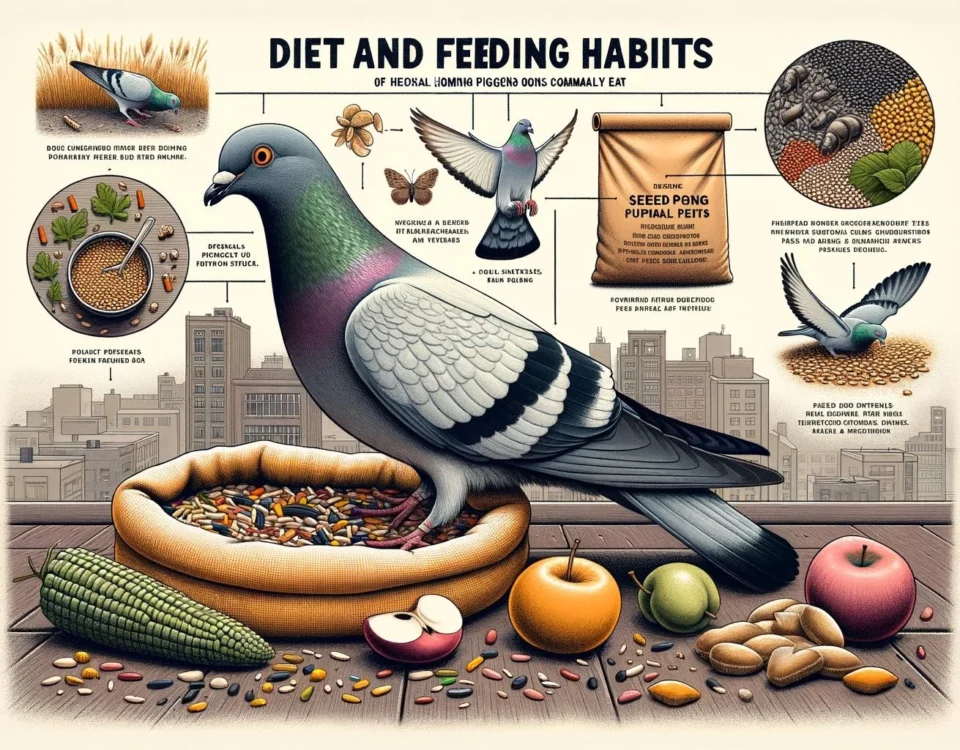Understanding Homing Pigeons and Their Instincts
Homing pigeons, scientifically known as Columbia livia, possess a remarkable knack for finding their way back home from significant distances. This instinctive ability has been harnessed throughout history, particularly as a means of communication during wartime. Often called Rock pigeons, these birds undergo training starting at a young age—typically between 6 and 8 weeks—to enhance their innate navigation skills.
Training these birds involves creating an optimal setting and employing techniques that fortify their homing instincts. Initially, young pigeons engage in loft flying to acquaint themselves with their environment. As they progress, the training distances increase. The use of whistles and feeding schedules can further refine their responsiveness and conditioning.
Providing a secure habitat is vital for successful training. A well-ventilated, clean loft ensures the health and safety of the pigeons. Features like trapping devices and one-way openings facilitate controlled access to the loft.
Breeding plays a pivotal role in maintaining favorable training conditions. Key aspects include:
- nesting arrangements,
- mating processes,
- rearing young pigeons (known as squabs),
- feeding routines,
- healthcare provisions,
- veterinary attention,
- banding practices,
- registration procedures,
- inventory management.
By grasping these elements of homing pigeons’ instincts and offering appropriate care through well-planned training methods such as confidence-building activities or conditioning regimens—you can effectively utilize their natural talents for racing or ceremonial events while ensuring they remain healthy throughout their lives.
What is the Homing Instinct?
Homing pigeons possess an extraordinary instinct that enables them to return to their nests from vast distances. This remarkable ability has been pivotal throughout history, particularly during the World Wars, where they carried messages across enemy territory. Their outstanding navigation skills were essential for communication during these conflicts. Even today, this talent is appreciated in pursuits such as racing and ceremonial releases. The homing instinct remains a primary reason why these pigeons are cherished in various domains.
Creating a Safe Environment for Training Homing Pigeons
To train homing pigeons effectively, it’s vital to create a safe environment that promotes their well-being and sharpens their navigation abilities. A fundamental aspect of this is designing a secure loft. The loft must shield the birds from predators while ensuring proper airflow. It should be spacious enough to accommodate nesting boxes and provide a landing board for the pigeons.
- good ventilation within the loft is essential to maintain fresh air, which helps prevent respiratory issues among the birds,
- keeping the space clean is equally crucial; routine cleaning minimizes disease risks, fostering a healthy training setting,
- incorporating trapping devices and one-way openings in the loft facilitates controlled access for pigeons.
These features help manage how birds enter and exit, enhancing safety by reducing exposure to external dangers. Overall, focusing on elements like security measures, effective ventilation, and cleanliness significantly improves the training conditions for homing pigeons.
Designing a Secure Loft
Ensuring a secure loft is vital when training homing pigeons. Elevating the structure off the ground helps deter predators, while using durable materials ensures it withstands various weather conditions. Incorporating a small lockable door with a landing board is also crucial; this design allows pigeons to enter with ease while keeping unwanted guests at bay. Inside, it’s important to include:
- nesting boxes,
- roosts,
- ledges.
These elements offer comfort and encourage natural activities such as resting and nesting.
Moreover, proper ventilation plays an essential role. It maintains good air quality, reducing the likelihood of respiratory diseases among pigeons. By adhering to these guidelines, you can establish a safe haven that supports effective pigeon training.
Importance of Ventilation and Cleanliness
Maintaining a well-ventilated and clean loft is essential for the well-being of homing pigeons. Ensuring good airflow prevents harmful gases from accumulating, which lowers the risk of respiratory issues. Keeping the loft clean regularly minimizes pathogens, providing a healthier environment. This care helps create optimal conditions for training the birds effectively.
Using Trapping Devices and One-Way Openings
Trapping devices and one-way openings are essential elements in loft design for training homing pigeons. Tools such as trapdoors and bobs allow the birds to enter the loft effortlessly while preventing their exit. This control is crucial in the initial phases of training, helping the pigeons acclimate to their new environment without returning to their original location. By implementing these mechanisms, trainers can effectively oversee pigeon movement, ensuring their safety and reducing stress. Drop traps further enhance security by permitting entry but restricting exits, thereby supporting successful pigeon training methods.
Breeding and Care for Optimal Training
Proper breeding and attentive care are vital when training homing pigeons. It all begins with setting up a secure and cozy nesting space to facilitate mating. Creating the ideal environment for raising young pigeons, known as squabs, is equally important. These young birds require carefully managed feeding schedules to support their rapid growth.
A well-rounded diet plays a significant role in maintaining their health and ensuring peak performance. Incorporating grains, seeds, and minerals into their daily meals provides the necessary nutrition. Routine visits to the vet can promptly identify any health concerns, allowing for swift intervention.
- marking each pigeon with bands helps track its ancestry,
- monitor its progress throughout training,
- keeping organized records aids in managing your inventory efficiently.
In essence, focused breeding practices combined with meticulous care lay the groundwork for successful pigeon training.
Nesting, Mating, and Raising Squabs
Raising homing pigeons encompasses providing nesting areas, facilitating mating, and nurturing the young birds, or squabs. Nesting boxes play a crucial role by offering a sheltered space for pigeons to mate and tend to their offspring. Ensuring a secure environment is important for safeguarding both the parents and their chicks, promoting the robust development needed for subsequent training.
Taking proper care during these phases is essential. This means maintaining cleanliness in their habitat and monitoring the health of both adult pigeons and their young. Such diligent care helps ensure that the squabs grow strong, preparing them effectively for future participation in a homing pigeon program.
Feeding, Health Care, and Veterinary Needs
Providing homing pigeons with a well-rounded diet is crucial for their well-being and performance. These birds thrive on a combination of grains and seeds, supplying them with essential nutrients for energy and development. Incorporating grit into their diet aids digestion by helping break down food in their gizzards. Consistent health care is equally important, as regular visits to the vet can identify potential issues early, thereby preventing illnesses.
Bird-specialist veterinarians play a key role in ensuring pigeons receive appropriate vaccinations and treatments. Monitoring changes in weight and behavior can alert caregivers to any signs of sickness. By combining proper nutrition with attentive health management, optimal conditions for training are established, which can enhance racing outcomes.
Incorporating these strategies into daily care not only enhances the quality of life for homing pigeons but also effectively prepares them for the challenges of training while supporting their innate instincts.
Banding, Registration, and Inventory Management
Effectively managing homing pigeons involves a few critical practices:
- banding is the process of attaching a unique ID band to each bird’s leg, which is crucial for differentiating them and tracking their training progress and health,
- registration involves documenting the pedigree or bloodline of each pigeon,
- inventory management entails maintaining detailed records of all pigeons, including their breeding history and training achievements.
Registration information is vital for making informed breeding decisions while maintaining the integrity of the flock’s lineage. Keeping accurate records enables breeders to monitor desirable traits within specific bloodlines, ultimately enhancing the quality of future generations.
Efficient tracking helps trainers refine breeding strategies and assess each bird’s performance over time. By integrating these practices into daily care routines, breeders can ensure organized flock management and achieve better training outcomes overall.
Preparing Young Pigeons for Training
Training young pigeons to develop their homing abilities requires a systematic process that begins when they reach about four weeks of age. At this stage, they are moved to a young bird loft where they start learning to recognize feeding signals, such as a whistle or the sound of a feed can being shaken. These cues indicate meal times and prompt their attentiveness.
It’s essential to introduce them early to loft flying, as this helps them associate the loft as their home base. Around six weeks old, you can open the aviary doors an hour before feeding time, allowing them their initial flights around the loft. This experience fosters both familiarity and confidence.
Gradually extending training distances is key to building endurance in these young birds. By mid-May, road training can commence with release points progressively farther from home.
A structured approach ensures that by six to seven weeks old, pigeons acclimate well without developing bad habits that could impede their training. Maintaining daily loft flying until road training begins further strengthens their homing instincts and readies them for longer journeys ahead.
Importance of Early Loft Flying
Allowing young homing pigeons to fly freely around the loft from an early age is crucial. This activity helps them develop a strong connection to their home base. By spending the initial weeks circling the loft, they increase their chances of returning successfully from far-off locations in the future. This process anchors the loft as their home, which is vital for honing their navigation abilities.
As these birds gain confidence and become more acquainted with their environment, they are prepared to tackle more advanced training phases that involve bigger challenges and longer flights.
Training Young Birds and Squeakers
Training young birds, known as squeakers, is crucial for honing their homing skills. Begin with brief flights close to the loft to familiarize them with their environment and boost their confidence. This initial exposure is essential in making the loft feel like home. As the birds grow more comfortable, gradually extend the flight distances to enhance their endurance and strengthen their natural navigation instincts.
A well-structured training schedule aids this gradual progression. Consistency helps maintain focus and discipline among the birds, fostering an atmosphere where they can thrive. By carefully managing each phase of training, trainers ensure that young pigeons acquire vital flying skills without becoming overwhelmed.
Distance training further refines their ability to navigate. Release them from progressively farther locations away from home. This practice not only builds physical stamina but also sharpens mental agility by challenging them with longer flights.
- blending short initial flights with systematic increases in distance,
- effectively preparing squeakers for races or other activities,
- enhancing their inherent homing capabilities.
Building Endurance and Stamina
Building endurance and stamina in homing pigeons involves strategic planning. Trainers employ various methods, such as:
- training tosses,
- gradually extending racing distances,
- progressively shifting the release locations.
Initially, birds are released from nearby spots to boost their confidence in navigating home. Over time, these distances increase, demanding more physical exertion and enhancing their stamina.
Consistency is key for optimal results; a regular training schedule is crucial. It should be challenging enough to push the birds without overwhelming them. Adjusting release points based on each pigeon’s progress helps ensure steady improvement in both endurance and navigation abilities. This approach prepares pigeons effectively for races by honing their natural instincts while maintaining their health and readiness for extended flights.
Training Techniques for Homing Pigeons
Training homing pigeons focuses on enhancing their innate ability to return home. One popular technique involves gradually increasing the distance from which the pigeons are released, honing their navigational skills and building stamina for longer journeys.
- whistle training is another valuable method,
- trainers use a specific whistle sound during feeding times, teaching pigeons to associate this signal with returning home swiftly,
- this auditory cue reinforces their natural routine and strengthens their homing instinct.
Building confidence is also vital in pigeon training. It begins with simple releases that grow more complex over time, helping pigeons trust in their own navigation abilities. Conditioning plays a key role here, ensuring they remain fit for races or lengthy trips.
By incorporating these strategies into a training regimen, the reliability and performance of homing pigeons can be significantly enhanced, preparing them well for races or ceremonial functions.
Progressive Release Points and Distance Training
Progressive release points and distance training are essential techniques to enhance pigeons’ homing abilities. Initially, pigeons are released close to their lofts. As they become accustomed, the release distance is gradually extended to one mile, then five miles, and beyond. This gradual method allows pigeons to learn navigation while also increasing their endurance.
Training tosses are crucial in this process. They involve setting pigeons free from various locations with progressively longer distances, which challenges their mental agility and steadily improves their stamina. A regular training schedule provides structure and routine.
Distance training not only strengthens the birds physically but also hones their natural instincts. By gradually increasing the flight distances, trainers help pigeons build confidence in finding their way back home from greater distances. Incorporating these techniques into pigeon training enhances performance for races or other activities requiring strong navigational skills.
Using Whistle Training and Feeding Schedules
Whistle training involves using a unique whistle sound to indicate feeding times for homing pigeons. This technique associates the noise with food, prompting pigeons to swiftly return to their loft. Consistent use of this method enhances the birds’ natural homing abilities, making it an integral aspect of their training.
An organized feeding schedule plays a crucial role in pigeon training. Regular meal times help manage their daily routines, encouraging both discipline and predictability. When combined with whistle signals, it enhances communication between trainers and pigeons, ensuring that the birds associate the loft with security and sustenance.
By merging whistle cues with feeding schedules, pigeons develop strong navigation skills. This not only boosts their physical fitness but also strengthens mental connections essential for effective homing.
The Confidence Method and Conditioning
To train homing pigeons effectively, the Confidence Method and conditioning are key. This technique involves:
- slowly increasing the release distance,
- ensuring that the birds consistently find their way back home,
- building their confidence in navigating once they successfully return from a distance three times.
This gradual training gets them ready for races that exceed 100 miles.
Conditioning plays a crucial role through:
- positive reinforcement,
- regular training schedules.
It enhances the pigeons’ physical fitness and reliably shapes them into excellent homing birds. Consistent routines help them develop both endurance and stamina for extended flights.
By blending the Confidence Method with proper conditioning, you can prepare pigeons thoroughly for racing or long-distance communication tasks.








